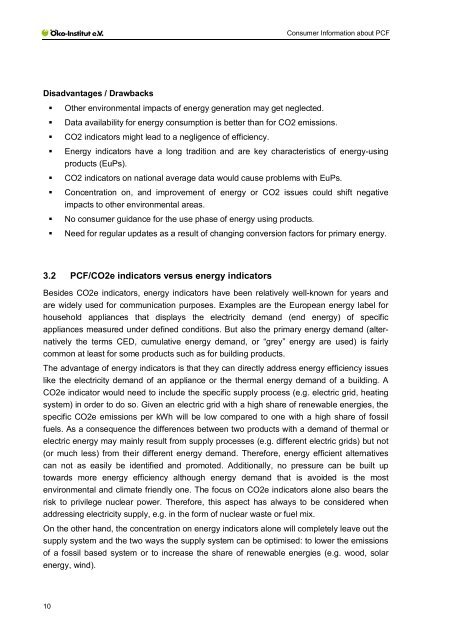Requirements on Consumer Information about Product ... - ANEC
Requirements on Consumer Information about Product ... - ANEC
Requirements on Consumer Information about Product ... - ANEC
Create successful ePaper yourself
Turn your PDF publications into a flip-book with our unique Google optimized e-Paper software.
C<strong>on</strong>sumer Informati<strong>on</strong> <strong>about</strong> PCF<br />
Disadvantages / Drawbacks<br />
• Other envir<strong>on</strong>mental impacts of energy generati<strong>on</strong> may get neglected.<br />
• Data availability for energy c<strong>on</strong>sumpti<strong>on</strong> is better than for CO2 emissi<strong>on</strong>s.<br />
• CO2 indicators might lead to a negligence of efficiency.<br />
• Energy indicators have a l<strong>on</strong>g traditi<strong>on</strong> and are key characteristics of energy-using<br />
products (EuPs).<br />
• CO2 indicators <strong>on</strong> nati<strong>on</strong>al average data would cause problems with EuPs.<br />
• C<strong>on</strong>centrati<strong>on</strong> <strong>on</strong>, and improvement of energy or CO2 issues could shift negative<br />
impacts to other envir<strong>on</strong>mental areas.<br />
• No c<strong>on</strong>sumer guidance for the use phase of energy using products.<br />
• Need for regular updates as a result of changing c<strong>on</strong>versi<strong>on</strong> factors for primary energy.<br />
3.2 PCF/CO2e indicators versus energy indicators<br />
Besides CO2e indicators, energy indicators have been relatively well-known for years and<br />
are widely used for communicati<strong>on</strong> purposes. Examples are the European energy label for<br />
household appliances that displays the electricity demand (end energy) of specific<br />
appliances measured under defined c<strong>on</strong>diti<strong>on</strong>s. But also the primary energy demand (alternatively<br />
the terms CED, cumulative energy demand, or “grey” energy are used) is fairly<br />
comm<strong>on</strong> at least for some products such as for building products.<br />
The advantage of energy indicators is that they can directly address energy efficiency issues<br />
like the electricity demand of an appliance or the thermal energy demand of a building. A<br />
CO2e indicator would need to include the specific supply process (e.g. electric grid, heating<br />
system) in order to do so. Given an electric grid with a high share of renewable energies, the<br />
specific CO2e emissi<strong>on</strong>s per kWh will be low compared to <strong>on</strong>e with a high share of fossil<br />
fuels. As a c<strong>on</strong>sequence the differences between two products with a demand of thermal or<br />
electric energy may mainly result from supply processes (e.g. different electric grids) but not<br />
(or much less) from their different energy demand. Therefore, energy efficient alternatives<br />
can not as easily be identified and promoted. Additi<strong>on</strong>ally, no pressure can be built up<br />
towards more energy efficiency although energy demand that is avoided is the most<br />
envir<strong>on</strong>mental and climate friendly <strong>on</strong>e. The focus <strong>on</strong> CO2e indicators al<strong>on</strong>e also bears the<br />
risk to privilege nuclear power. Therefore, this aspect has always to be c<strong>on</strong>sidered when<br />
addressing electricity supply, e.g. in the form of nuclear waste or fuel mix.<br />
On the other hand, the c<strong>on</strong>centrati<strong>on</strong> <strong>on</strong> energy indicators al<strong>on</strong>e will completely leave out the<br />
supply system and the two ways the supply system can be optimised: to lower the emissi<strong>on</strong>s<br />
of a fossil based system or to increase the share of renewable energies (e.g. wood, solar<br />
energy, wind).<br />
10
















